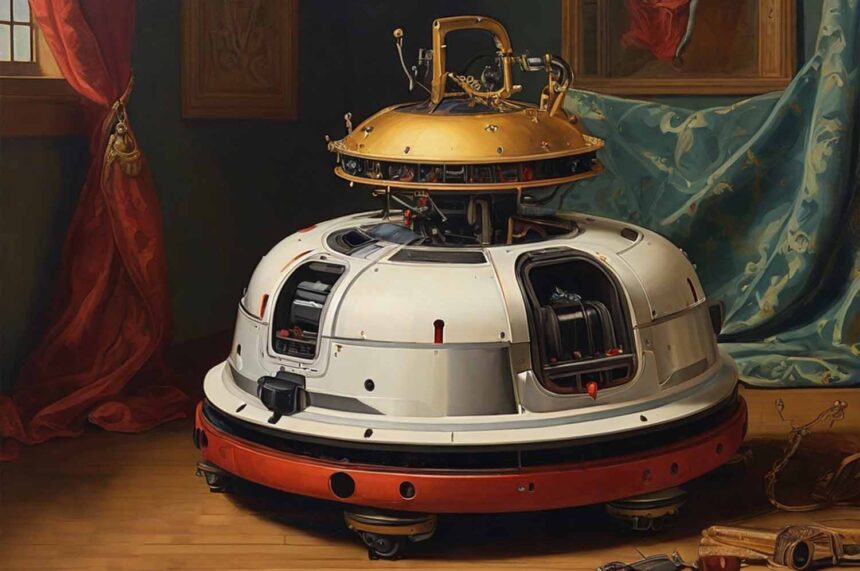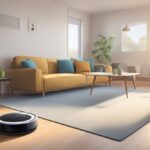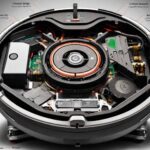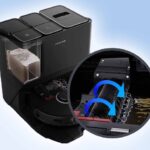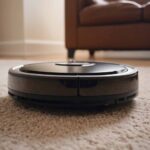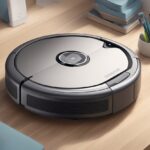The origin of the robotic vacuum cleaner dates back to the late 20th century, with the first model introduced by Electrolux in 1996.
This device, known as the Trilobite, marked a seminal point in the history of household cleaning, providing a glimpse into the future of autonomous domestic technology.
These early robot vacuums began as simple machines, designed primarily to navigate spaces and clean floors with minimal human intervention.
Advancements in technology have significantly influenced the evolution of the robotic vacuum cleaner.
Companies like Dyson and Samsung have contributed to the development of more sophisticated models equipped with Artificial Intelligence (AI), LIDAR technology, and complex sensor arrays.
These enhancements have improved object recognition and obstacle detection capabilities, allowing robot vacuums to clean more effectively and efficiently.
Throughout its development, the robot vacuum has become a symbol of the modern smart home, intertwining necessity with innovation.
With continual improvements, these robots represent more than just cleaning tools; they have redefined the concept of convenience in the everyday lives of consumers.
Timeline highlighting key milestones in the development of robot vacuum technology:
| Year | Milestone | Details |
|---|---|---|
| 1996 | First Robot Vacuum Concept | Electrolux introduces Trilobite, the first prototype robot vacuum. |
| 2002 | Commercial Availability | iRobot releases Roomba, the first commercially successful robot vacuum. |
| 2004 | Advancements in Navigation | Development of more advanced navigation systems for more efficient cleaning. |
| 2010 | Introduction of Mapping Technology | Robot vacuums begin to incorporate mapping technology for better area coverage. |
| 2015 | Smart Home Integration | Robot vacuums start to integrate with smart home systems for enhanced functionality. |
| 2018 | AI and Machine Learning | Introduction of AI and machine learning for improved obstacle detection and cleaning efficiency. |
| 2021 | Self-Emptying Technology | Launch of robot vacuums with self-emptying technology, reducing manual intervention. |
Early Inventions and Innovations
The inception of robot vacuums marked a paradigm shift in cleaning technology. The forerunners in this arena were marked by pioneering efforts from companies like Electrolux and Dyson, setting the stage for a new category of domestic robots.
Electrolux Trilobite
The first notable robot vacuum cleaner, the Electrolux Trilobite, materialized in the market in 1996.
This groundbreaking device, named after an extinct marine arthropod, embodied the cutting-edge of home cleaning technology.
It could autonomously navigate a living space, discerning obstacles and cliffs, thus avoiding potential falls. Despite its somewhat rudimentary navigational abilities by today’s standards, the Trilobite was a significant leap forward for autonomous domestic aides.
Dyson’s Unreleased DC06
On the other hand, Dyson, a company often synonymous with innovation in the vacuum cleaner market, developed the DC06.
A foray that never reached commercial production, the DC06 was an ambitious project spearheaded by Sir James Dyson himself.
Even though this robot vacuum had potent cleaning capabilities and intricate technology, its high manufacturing costs led to the project’s cessation.
Nevertheless, the conceptualization and development of the DC06 by Dyson’s team contributed to the future landscape of robot vacuums, setting benchmarks in suction proficiency and navigational intelligence.
Technological Advancements
The evolution of robot vacuum cleaners has been driven by significant progress in sensors, navigation, and automation technologies, which have enhanced both their efficiency and their level of autonomy.
Sensors and Navigation
In the realm of robot vacuum cleaners, sensors are the core components that empower them to navigate through complex environments.
Advanced laser-vision systems, such as those developed by companies like Dyson and Samsung, emit laser beams to measure distances and create a precise map of the cleaning area.
These sophisticated sensors, along with ultrasound technology, have been instrumental in improving object recognition and obstacle detection, ensuring a seamless cleaning process without human intervention.
Robot vacuums equipped with these sensors are able to systematically traverse a space, rather than moving randomly, which increases their cleaning efficiency.
This methodical approach to movement cuts down on repeated cleaning of the same area and ensures that no spots are missed.
Battery and Automation
Robot vacuum cleaners have seen advancements in their battery life and automation capabilities. Long-lasting lithium-ion batteries have replaced older, less efficient battery types, allowing for extended cleaning sessions and reduced downtime.
Furthermore, the integration of smart home technology has enabled users to schedule cleanings and control their robot vacuums through smartphone apps or voice commands, increasing the level of autonomy of these devices.
The cleaning technology itself has also improved, with various models incorporating multiple cleaning modes and suction powers suitable for different types of dirt and debris.
Each advancement in technologies, from the sensors that guide these intelligent machines to the battery powering them, contributes to a more autonomous and effective cleaning experience.
Commercial Breakthroughs and Popular Models
The market has witnessed significant strides in robotic vacuum technology, particularly with the introduction of the iRobot Roomba series and the products from Neato Robotics, which stand as landmark achievements in the sector.
iRobot Roomba Series
The iRobot Roomba series serves as a flagship in the world of domestic robot cleaners.
The first Roomba was introduced to the public in 2002, initiating a new era of cleaning with its intelligent sensors and ease of use.
Over the years, iRobot’s dedication to innovation has kept Roomba at the forefront of the best robot vacuum options available.
Each new model integrated advancements in navigation, debris pickup, and smart home compatibility, maintaining Roomba’s status as a household name for robotic vacuum cleaners.
Neato Robotics
Neato Robotics differentiates itself with a unique D-shaped design that allows its vacuums to reach corners and edges more effectively compared to round-shaped models.
They were among the first to introduce laser-guided navigation in 2010, demonstrating their commitment to improving domestic robot functionality.
Neato’s emphasis on powerful suction and methodical cleaning patterns has positioned them as a strong competitor in the market and a favorite among consumers seeking reliable and efficient robotic vacuum cleaners.
Enhancing User Experience
In the continuous refinement of robot vacuums, manufacturers have prominently focused on the addition of features such as spot cleaning, self-emptying capabilities, and noise reduction strategies.
These advancements aim at providing more convenience and efficiency to users, elevating the cleaning experience to new levels of sophistication.
Spot Cleaning and Mopping Functions
Robot vacuums have evolved to offer specialized spot cleaning modes that target specific areas of a room with concentrated suction.
This is particularly beneficial for dealing with localized spills or high-traffic zones.
Equally important is the integration of mopping functions with built-in water tanks, which dispense the right amount of water to deal with different levels of grime and ensure a thorough clean.
Self-emptying and Noise Reduction
The introduction of self-emptying robot vacuums has significantly increased user convenience, as it minimizes the frequency of manual interventions.
The dirt is automatically transferred from the vacuum to a larger bin, which only needs to be emptied occasionally.
Additionally, the pursuit of a quiet operational volume has led manufacturers to design vacuums with improved noise reduction, making them unobtrusive and more suitable for everyday use.
Enhanced brushes contribute to this as well, efficiently picking up debris while keeping the noise level down.
The Future of Robot Vacuums
As robot vacuums become increasingly normalized within domestic settings, their evolution gears toward more sophisticated AI capabilities and deeper smart home integration.
This progression promises to heighten home cleaning efficiency and provide affordable solutions that save time.
Smart Home Integration
Robot vacuums are poised to become an integral part of the smart home ecosystem. With improvements in connectivity, future models will communicate seamlessly with other smart devices, allowing for a centralized and synchronized home management system.
This means a robot vacuum could start cleaning the moment someone leaves the house or halt when the smart doorbell detects a visitor.
- Integration features:
- Activation via voice commands
- Scheduling through smart home apps
- Reporting to the homeowners on cleaning status
Advanced AI and Machine Learning
The application of AI and machine learning stands at the forefront of transforming robot vacuums.
As these domestic robots learn from their environment, they’ll offer more personalized cleaning experiences, adapting to different room layouts and recognizing changes in the home.
- AI enhancements:
- Real-time navigation and obstacle avoidance
- Predictive maintenance and self-diagnosis of issues
- Learning capabilities to optimize cleaning patterns
By harnessing these technologies, robot vacuums will not only enhance home cleaning but also redefine the efficiency and quality of upkeep in modern homes.
Challenges and Considerations
The development of robot vacuums encompasses nuanced challenges, particularly in obstacle detection and avoidance and navigating cost and market trends.
As these devices become more integrated into household cleaning routines, addressing these aspects is crucial for manufacturers and consumers alike.
Obstacle Detection and Avoidance
Robot vacuums rely on sophisticated sensors to navigate around a variety of obstacles during the cleaning process.
Central to this technology are cameras and depth sensors that map the environment and identify potential obstructions.
Despite advances, vacuum robots can still get stuck on unexpected objects or complex room layouts.
The integration of more advanced algorithms and camera-based navigation systems has been pivotal in mitigating these issues, enhancing the vacuum’s ability to maneuver through tight spaces and around obstacles seamlessly.
Cost and Market Trends
The robot vacuum market is sensitive to cost dynamics. Early models were seen as expensive, which limited their accessibility to a broader consumer base.
However, with technological advancements and economies of scale, prices have started to decrease.
Current market trends indicate a growing demand for these cleaning devices, although manufacturers must continually balance between cutting-edge features and affordability to appeal to diverse consumers.
An analysis of sales patterns shows that as prices become more competitive, the technology becomes more ubiquitous, expanding the role of automated vacuuming solutions in cleaning practices worldwide.


